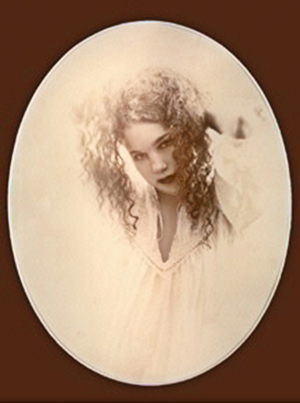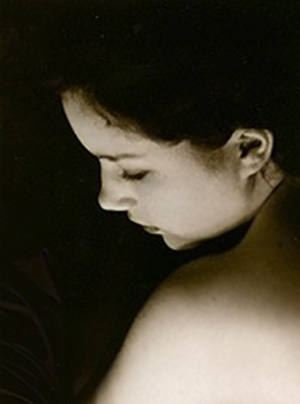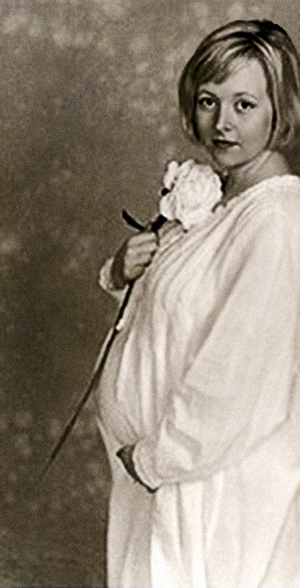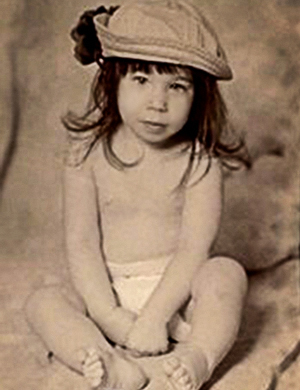When I was young, my parents bought me my first camera- a plain old manual Nikon. My dad gave me a lesson about apertures and shutter speeds and loading film. During the next several months, I took pictures of my friends, my house, and my family. The problem was that I knew how to use the camera, but I didn’t know how to take a picture. There was no artistry to my photos. I was stuck with hundreds of boring snapshots. Years passed before I discovered how to make a photograph speak. In fact, I’m still learning, even now as a professional.
I found that by challenging myself, my photography improved, so here is a challenging assignment to help you become a creative photographer. If you’re up for the challenge, give it a go.

The model for this photo wore vintage clothing from my collection. Her pose and long hair make a classic-looking photo. This photo is also a vignette, which makes her fade into the background.
THE ASSIGNMENT
Take six little pieces of paper and write one of the following words down on each: “death,” “life,” “joy,” “peace,” “love,” and “new.” Place each piece of paper in a bag and choose one each month. Your assignment is to spend the month documenting your chosen word. Let’s take “death,” for example. It’s easy to go out and photograph a cemetery. That’s too obvious and the first thing most people would do.
So don’t do it.
Take your time and think about a new way to interpret the word “death.” You don’t have to take “death” literally. Try documenting what happens to nature as winter approaches. How about photographing old buildings that are falling apart? Or you could document the death of a friendship and combine it with original poetry. Consider the goal of documentary photography- it tells a story.
Choose your own personal interpretation of “death,” “life,” “joy,” “peace,” “love,” and “new.” Once you’ve selected a subject in each category, stick with it during the month’s photo sessions. Think of each word as an emotion to be expressed through photography. Don’t worry if nothing comes to mind right away. It may take days before you get an idea. That’s okay.
Note: Let’s say you chose “death” as your first word. Now, don’t take three pictures of nature and then some pictures of dilapidated barns for your interpretation of “death”. Choose either barns or nature in order to create a portfolio with a subject theme that will tell that story.

Women often posed with their shoulders or backs to the camera in the early days of photography. It is certainly still a pleasing pose today.
COMPOSITION
You don’t always need to show the entire object. If your subject is a classic car, for example, people will still know it’s a classic car even if you include only the front grill or a headlight. Try to look for interesting details about your subject and focus in tight.
ANGLES
Don’t be afraid to get down on the ground or above it. Climb a ladder or a step ladder to photograph something. Choose a variety of angles and focal lengths. Try some close-ups, some medium shots, and some farther away.

This mother-to-be wanted to appear classic and old-fashioned. She may seem to have a more modern haircut, but women living in the 1920’s cut their hair the same way. Add a bit of noise and soft light and it adds to the look. She’s wearing a linen nightgown I found at a flea market. I often buy unusual clothing or props at thrift shops and flea markets to use in my photos.
MY PHOTO INTERPRETATIONS
The photos you see here are my personal interpretations of the word “old.” I decided to give these portraits a vintage look by changing them to sepia tones. Remember, though, sepia toning will not automatically give a photo a vintage look. You must also take care to avoid modern clothing, settings, and poses.
If you study old photographs, you’ll notice a few things. Since lenses were not as sharp years ago as they are today, old photos are slightly grainy and fuzzy. I did my best to copy this effect by using an older lens of poor quality and adding noise where I see fit just for this reason. If you’d like to try re-creating this interpretation, it would be a good idea for you to study old photographs first. I hope you think my personal interpretation of “old” was successful.

This baby posed for me dressed only in a diaper and a hat found in a vintage store. The added noise and the fact that the picture is printed on fiber-based paper with a matte finish makes the final product look old and faded. Imagine it framed in an antique picture frame.
PUTTING THEM ALL TOGETHER FOR SHOW AND TELL
Once you complete all six assignments, take a look at your work and study the images. Which are your favorite interpretations? choose the best ten pictures. You have basically created an exhibit – a group of photos with a common theme. Share them with family, friends and online.
Do other people understand what you were trying to say? Are you satisfied with the project? There are no mistakes – only opportunities from which to learn. This is a lesson in creative thinking. Knowing how to think creatively will enhance any new challenges you’ll face.
By Marci Cooke
Article and photos: © Marci Cooke. All rights reserved.

Leave a Reply